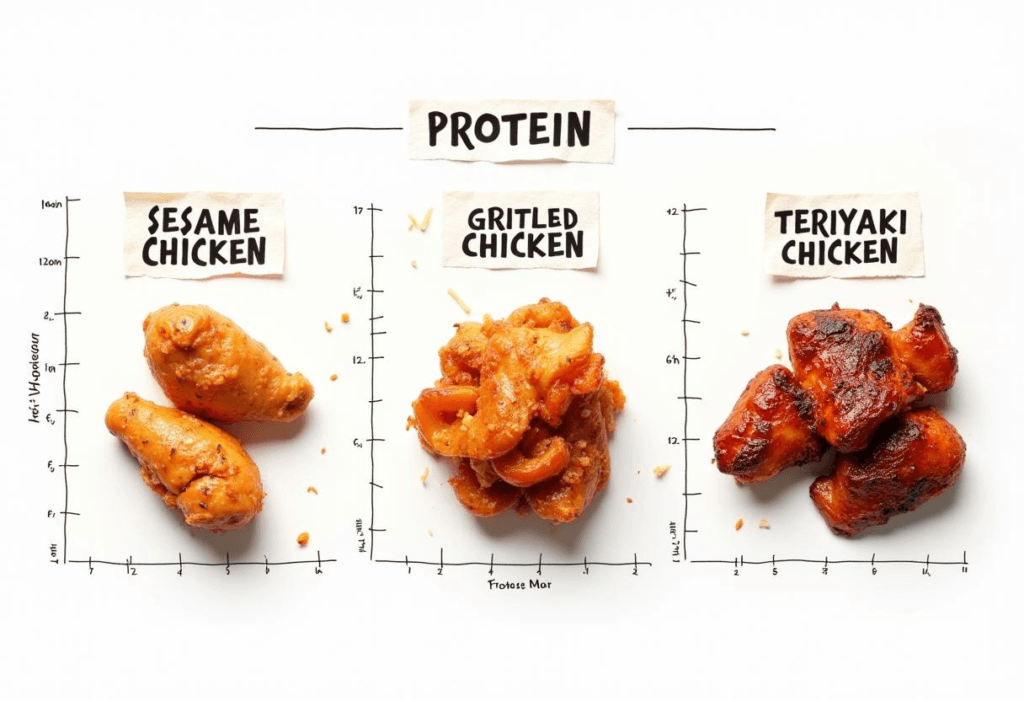What Is Sesame Chicken?
Sesame chicken is a beloved Chinese-American dish known for its crispy fried chicken pieces coated in a sweet, tangy sesame sauce. If you’ve ever ordered it from a restaurant, you know how deliciously addictive it can be. But is it high in protein, or is it just another indulgent meal that packs more sugar and fat than nutrients?
« Sesame chicken may seem like a protein-packed dish, but its deep-fried coating and sugary sauce can significantly affect its nutritional value. » – Dr. Emily Carter, Nutritionist
Before we break down its protein content, let’s take a closer look at what’s actually inside this dish.
The Origin and Popularity of Sesame Chicken
Sesame chicken, as we know it today, originated in Chinese-American cuisine, though it takes inspiration from traditional Asian flavors. While it’s not authentically Chinese, its combination of crispy chicken, soy sauce, honey, and sesame seeds has made it a staple in Chinese takeout menus worldwide.
🔹 Why is it so popular?
Crunchy texture from battered and fried chicken
Sweet and savory sauce with a slight tang
Rich, nutty flavor from sesame seeds and oil
But while it’s undeniably tasty, it’s time to ask: how does it stack up in terms of protein?
Is Sesame Chicken High in Protein? Nutritional Breakdown
Many people assume that because sesame chicken is made with chicken, it must be high in protein. However, the way it’s cooked and prepared can make a huge difference.
Protein Content in Sesame Chicken vs. Other Chicken Dishes
| Dish | Protein per 100g | Calories | Fat | Carbs |
|---|---|---|---|---|
| Sesame Chicken | 18g | 280 kcal | 12g | 25g |
| Grilled Chicken Breast | 31g | 165 kcal | 3.6g | 0g |
| Teriyaki Chicken | 22g | 250 kcal | 10g | 20g |
| General Tso’s Chicken | 16g | 300 kcal | 15g | 30g |
👉 Key Takeaway: Sesame chicken contains a decent amount of protein, but it’s lower than grilled chicken or teriyaki chicken due to its breading and sauce.
« While sesame chicken does provide protein, the added sugar and frying process reduce its overall nutritional value compared to healthier chicken dishes. » – Fitness Coach Mark Reynolds

How Cooking Methods Affect Protein Levels in Sesame Chicken
The way you cook chicken can increase or decrease its protein content. Sesame chicken is deep-fried, which:
Adds extra fat and calories
Reduces the lean protein-to-calorie ratio
Can cause some protein loss due to high heat exposure
Meanwhile, grilled or baked chicken retains more protein with fewer unnecessary calories.
« If you’re looking to keep the protein high while reducing fat, opt for baked or air-fried sesame chicken instead of deep-fried versions. » – Chef Lisa Chang
Health Benefits and Downsides of Sesame Chicken
Like most dishes, sesame chicken comes with both pros and cons. While it does provide some protein, it also has downsides that might make you rethink eating it regularly.
Pros: Protein, Healthy Fats, and Essential Nutrients
Decent protein content: With around 18g of protein per 100g, it still contributes to muscle growth and repair.
Healthy fats from sesame seeds: Sesame seeds contain omega-6 fatty acids, which support heart health.
Rich in iron and zinc: Chicken provides essential minerals that help with energy production and immunity.
Cons: High Calories, Sugar, and Sodium
High in calories: The deep-frying process adds extra fat, making it less ideal for weight loss.
Excess sugar in the sauce: Many recipes include honey, brown sugar, or cornstarch-based sauces, increasing carb content.
Sodium overload: Soy sauce and other seasonings contribute to high sodium levels, which can cause bloating and water retention.
How to Make High-Protein Sesame Chicken at Home
Want to enjoy sesame chicken without the guilt? Try making a healthier, high-protein version at home! By tweaking a few ingredients, you can increase protein, lower calories, and reduce sugar.
Choosing the Right Chicken Cut for More Protein
- ✅ Best Option: Skinless, boneless chicken breast (31g protein per 100g)
- ✅ Good Alternative: Chicken thigh (24g protein per 100g)
« Using lean chicken breast instead of thighs or drumsticks can significantly boost the protein content of your sesame chicken. » – Dietitian Amanda Lee

Low-Calorie and High-Protein Sesame Chicken Recipe
Ingredients:
| Ingredient | Quantity |
|---|---|
| Chicken breast (cubed) | 500g |
| Egg whites | 2 |
| Cornstarch (for coating) | 2 tbsp |
| Sesame oil | 1 tbsp |
| Soy sauce (low sodium) | 2 tbsp |
| Honey | 1 tbsp |
| Garlic (minced) | 2 cloves |
| Ginger (grated) | 1 tsp |
| Sesame seeds | 1 tbsp |
| Green onions (chopped) | 2 stalks |
Instructions:
1️⃣ Prepare the chicken: Toss cubed chicken in egg whites and cornstarch for a light coating.
2️⃣ Air-fry or bake: Instead of deep-frying, bake at 375°F (190°C) for 20 minutes or air-fry for 12 minutes at 400°F.
3️⃣ Make the sauce: Heat sesame oil in a pan, then add garlic, ginger, soy sauce, and honey. Stir well.
4️⃣ Combine: Toss cooked chicken in the sauce, coating evenly.
5️⃣ Garnish & Serve: Sprinkle sesame seeds and chopped green onions before serving.
🛑 Nutrition Per Serving (150g):
| Calories | Protein | Fat | Carbs |
|---|---|---|---|
| 230 kcal | 35g | 7g | 12g |
« This healthier sesame chicken recipe keeps the flavor while nearly doubling the protein per serving compared to restaurant versions! » – Chef Tom Mitchell
Coming Up Next: Comparing Sesame Chicken to Other High-Protein Dishes & Restaurant Tips!
So far, we’ve covered:
What sesame chicken is and its nutritional value
How cooking methods affect protein content
The pros and cons of eating sesame chicken
A high-protein, low-calorie homemade recipe
In Part 2, we’ll discuss:
🔥 How sesame chicken compares to grilled and teriyaki chicken
🔥 How to make healthier choices when ordering at restaurants
🔥 Common problems with sesame chicken and how to fix them
Is Sesame Chicken High in Protein? (Part 2 – Comparisons, Restaurant Tips & Solutions)
Welcome back! In Part 1, we explored the nutritional value of sesame chicken, how cooking methods affect protein levels, and even a healthier, high-protein homemade recipe. Now, let’s take things further by comparing sesame chicken to other high-protein chicken dishes, discussing how to order a healthier version at restaurants, and tackling common problems with sesame chicken.
Comparing Sesame Chicken to Other High-Protein Chicken Dishes
Sesame chicken is undoubtedly delicious, but is it the best choice for protein? Let’s compare it with other popular chicken dishes to see where it stands.
Sesame Chicken vs. Grilled Chicken: Which Has More Protein?
| Dish | Protein (per 100g) | Calories | Fat | Carbs |
|---|---|---|---|---|
| Sesame Chicken | 18g | 280 kcal | 12g | 25g |
| Grilled Chicken Breast | 31g | 165 kcal | 3.6g | 0g |
👉 Winner: Grilled Chicken Breast 🔥
Grilled chicken is the ultimate high-protein option. With 31g of protein per 100g and zero carbs, it’s perfect for muscle growth and weight loss. Sesame chicken, on the other hand, has added sugar and a deep-fried coating, which lowers its protein density.
« If protein is your goal, grilled chicken beats sesame chicken every time. It’s lean, packed with protein, and much lower in calories. » – Fitness Coach Jason Hill
Sesame Chicken vs. Teriyaki Chicken: Which Is Healthier?
| Dish | Protein (per 100g) | Calories | Fat | Carbs |
|---|---|---|---|---|
| Sesame Chicken | 18g | 280 kcal | 12g | 25g |
| Teriyaki Chicken | 22g | 250 kcal | 10g | 20g |
👉 Winner: Teriyaki Chicken 🥢
Teriyaki chicken has more protein and fewer calories than sesame chicken, making it the better option. While both dishes contain sweet sauces, teriyaki sauce typically has less sugar than sesame chicken sauce.
« Teriyaki chicken is a great alternative to sesame chicken if you’re looking for more protein with fewer calories. » – Nutritionist Linda Carter
How to Order a Healthier Version of Sesame Chicken at Restaurants
If you love ordering sesame chicken at restaurants, don’t worry—you don’t have to give it up! You just need to make smart modifications to boost protein and cut down on unnecessary calories.
Customizing Your Sesame Chicken for More Protein
When ordering at a restaurant, ask for these modifications:
Request grilled or baked chicken instead of fried – This removes the high-fat batter while keeping the flavor.
Ask for light sauce – Sesame sauce is usually loaded with sugar. Getting half the sauce can significantly lower carbs and calories.
Add extra protein – Ask for extra chicken or a side of steamed tofu or egg whites for a protein boost.
« Making small changes when ordering sesame chicken can transform it from a cheat meal to a high-protein, balanced dish. » – Chef Daniel Wong
Healthier Side Dishes to Pair with Sesame Chicken
Instead of pairing sesame chicken with white rice or fried rice, try these nutrient-dense sides:
| Side Dish | Nutritional Benefit |
|---|---|
| Steamed Broccoli 🥦 | High in fiber and vitamins |
| Brown Rice 🍚 | More fiber and protein than white rice |
| Quinoa 🍛 | High-protein alternative to rice |
| Steamed Edamame 🌱 | Packed with plant-based protein |
Pro Tip: Swapping white rice for quinoa or brown rice adds extra fiber and protein, keeping you fuller for longer.
Common Problems with Sesame Chicken and How to Fix Them
Even if you’re making sesame chicken at home, some issues might pop up. Let’s fix them!
Too Much Sugar and Calories: How to Reduce Them
🚫 Problem: Traditional sesame chicken sauce is loaded with sugar, honey, and cornstarch, leading to high carbs and excess calories.
✅ Solution:
- Use honey in moderation or swap it for monk fruit sweetener.
- Replace cornstarch with arrowroot powder for a low-calorie thickener.
- Add more garlic and ginger for extra flavor without sugar.
« Reducing sugar in sesame sauce keeps the flavor while making it much healthier. » – Dietitian Rachel Green
Balancing Protein and Healthy Fats in Sesame Chicken
🚫 Problem: Sesame chicken contains healthy fats from sesame oil and seeds, but the deep-frying process adds unnecessary saturated fat.
✅ Solution:
- Instead of deep-frying, air-fry or bake the chicken.
- Use extra sesame seeds instead of excessive sesame oil to keep flavor without the extra fat.
- Opt for lean chicken breast over thighs or drumsticks.
« Sesame oil and seeds add heart-healthy fats, but it’s important to keep portions in check to balance protein intake. » – Sports Dietitian Mark Lewis
Frequently Asked Questions About Sesame Chicken and Protein
Is sesame chicken a good protein source?
Yes, but it’s not the best. It provides about 18g of protein per 100g, but it’s lower in protein than grilled or teriyaki chicken due to added breading and sauce.
How can I make sesame chicken healthier?
Use baked or air-fried chicken, reduce the sugar in the sauce, and pair it with high-protein sides like quinoa or edamame.
What’s better for muscle building: sesame chicken or grilled chicken?
Grilled chicken is far superior for muscle building—it has more protein, fewer calories, and zero added sugars.
Can I eat sesame chicken on a high-protein diet?
Yes, but make adjustments! Choose lean chicken breast, reduce sauce, and pair it with high-protein sides for a more balanced meal.
Does sesame oil add protein to the dish?
No, sesame oil is a source of healthy fats, but it does not contain protein. The protein in sesame chicken comes entirely from the chicken.
Conclusion: Should You Eat Sesame Chicken for Protein?
So, is sesame chicken high in protein? Yes—but it’s not the best choice.
✅ Pros:
Contains moderate protein (18g per 100g)
Rich in flavor and healthy fats
Can be made healthier with small tweaks
Cons:
Lower in protein than grilled or teriyaki chicken
Higher in sugar, calories, and fat due to sauce and frying
Not ideal for muscle-building diets unless modified
If you love sesame chicken, you can still enjoy it—just make small changes like choosing grilled chicken, reducing sauce, and adding protein-rich sides. With these adjustments, you can keep the flavor while making it a healthier, high-protein meal! 🍗💪

